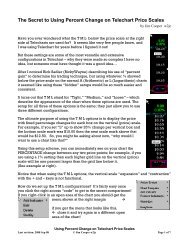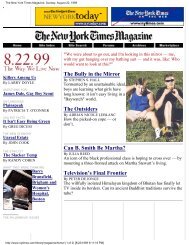The New York Times Magazine, Sunday, August 22 - Unauthorized ...
The New York Times Magazine, Sunday, August 22 - Unauthorized ...
The New York Times Magazine, Sunday, August 22 - Unauthorized ...
Create successful ePaper yourself
Turn your PDF publications into a flip-book with our unique Google optimized e-Paper software.
<strong>The</strong> Bully in the Mirror<br />
only incorporated into the larger person you try to become. I think that's what<br />
Garry Trudeau, the formerly small cartoonist, had in mind when he described life<br />
as a tall adult as that of a "recovering short person."<br />
t was during his sophomore year, getting "the daylights pounded out of him"<br />
in wrestling and gaining even more weight, that Alexander began what he<br />
calls, with justification, his "drastic transformation." He started by losing 30<br />
pounds in one month. For a time, he consumed only 900 calories a day, and<br />
ultimately got down to 152 pounds. He began to lift weights seriously, every day<br />
for three months straight. He started to read magazines like Flex and Men's<br />
Fitness. He briefly dabbled with muscle-building supplements like creatine. He<br />
got buff, and then beyond buff.<br />
By the time his sophomore year in high school began, Alexander had packaged<br />
his old self in a phenomenally new body, and it has had the desired effect. "My<br />
quality of social life changed dramatically when I changed my image," he said.<br />
He still maintained friendships with the guys in the computer lab, still<br />
programmed, still played Quake with dozens of others. But he worked out at the<br />
gym at least five times a week. He shifted his diet to heavy protein. He pushed<br />
himself to lift ever-heavier weights. Until an injury curtailed his season, he<br />
brought new strength to his wrestling. Still, he wasn't satisfied. When I asked<br />
him if he ever felt tempted to try steroids during his effort to remake his physical<br />
image, he denied using them, and I believe him. But he wasn't coy about the<br />
temptation. "When someone offers you a shortcut," he replied, "and it's a<br />
shortcut you want so bad, you're willing to ignore what it might be doing to your<br />
insides. I wanted to look better. Who cares if it's going to clog up my kidneys?<br />
Who cares if it'll destroy my liver? <strong>The</strong>re was so much peer pressure that I didn't<br />
care."<br />
Alexander was especially pleased by the good shape he was in -- although he<br />
didn't care for aerobics, his resting heart rate was low, he ran a mile under six<br />
minutes and seemed to have boundless energy. But fitness was only part of what<br />
he was after. As he put it: "No one's looking for a natural look, of being thin and<br />
in shape. It's more of looking toward a level beyond that." He added that "guys<br />
who work out, especially guys who have six-packs and are really cut up, are the<br />
ones girls go after."<br />
To be honest, I was a little dubious about this until I spoke with an admittedly<br />
unscientific sampling of teen-age girls. It turned out that they not only agreed<br />
with the sentiment, but also spoke the same lingo. "If you're going swimming or<br />
something like that, girls like the stomach best," said Elizabeth, a 14-year old.<br />
"Girls like it if they have a six-pack, or if they're really ripped, as they say. That's<br />
the most important thing. And arms too."<br />
http://www.nytimes.com/library/magazine/home/199908<strong>22</strong>mag-boys-self-image.html (13 of 18) [8/<strong>22</strong>/1999 9:17:23 PM]






